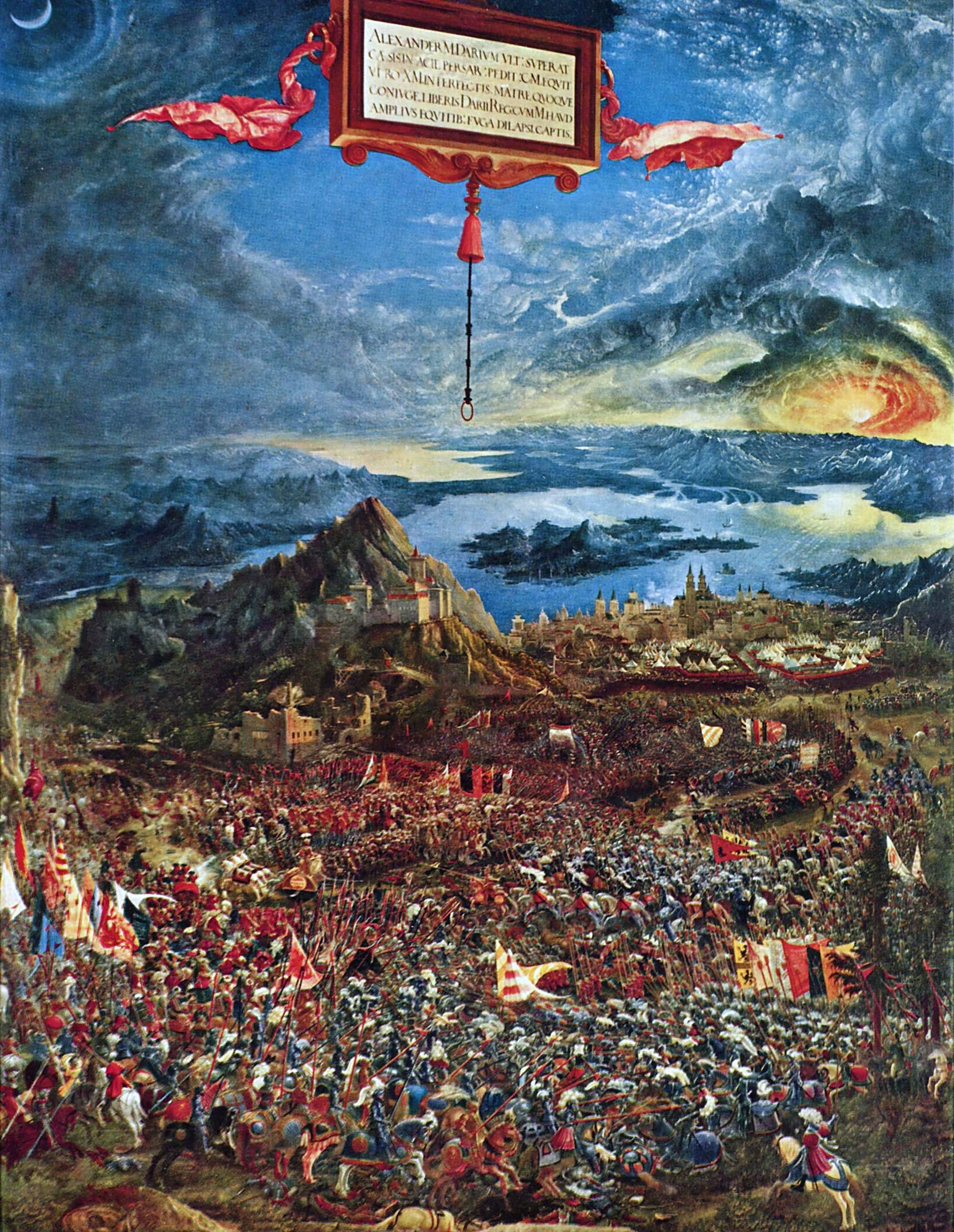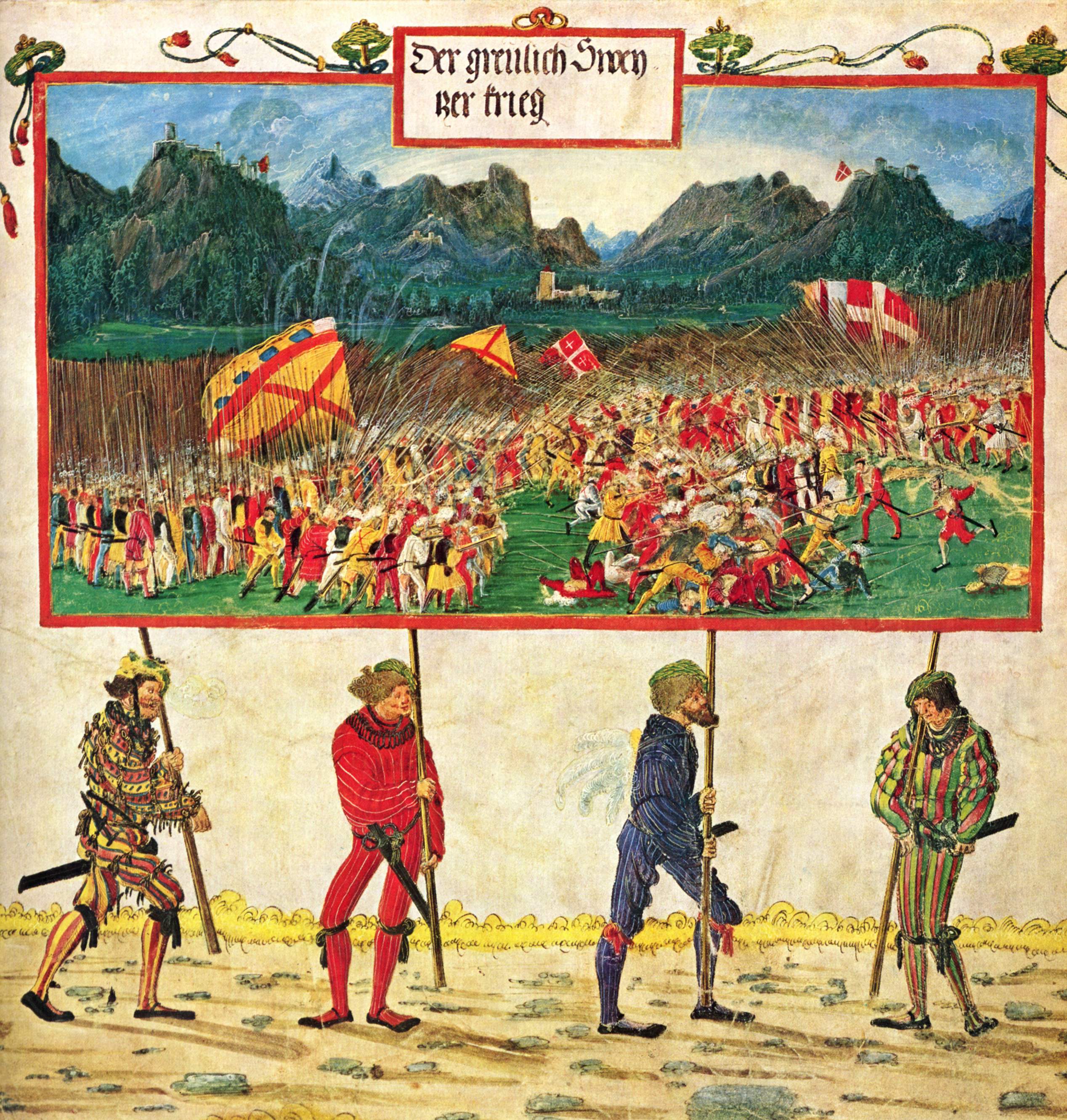- The Battle of Alexander at Issus
Infobox Painting

title=The Battle of Alexander at Issus
artist=Albrecht Altdorfer
year=1529
type=oil painting on panel
height=158.4
width=120.3
height_inch=
width_inch =
museum =Alte Pinakothek
city =Munich ,Germany "The Battle of Alexander at Issus" [Known by various similar titles such as "Battle of Alexander", "Battle of Issus" etc.] is
Albrecht Altdorfer 's (c. 1480 -1538 ) most famous painting.Cite web
url=http://www.ibiblio.org/wm/paint/auth/altdorfer/battle-issus/
title=Web Museum
accessmonthday=9 April
accessyear=2007] Painted in 1528-9, theoil painting Cite web
url=http://concise.britannica.com/ebc/art-8321
title=Encyclopaedia Britannica (Concise)
accessmonthday=9 April
accessyear=2007] depicts a youngAlexander the Great in333 BC , at the point of victory over thePersia n army of King Darius III in theBattle of Issus . The work was commissioned by theDuke ofBavaria and passed from the Bavarian royal collection to theAlte Pinakothek inMunich .Altdorfer and the painting
Albrecht Altdorfer made significant developments in landscape and
etching . He was also anarchitect , an engraver, and the leader of theDanube school of German painting. He was a near contemporary ofAlbrecht Dürer , and Grünewald's, with the influence of the latter more evident in his art. The "Heavenly Host above the Virgin and Child" (see Gallery) in theIsenheim Altarpiece has been compared to "The Battle of Alexander at Issus". This is shown in "The Battle of Alexander at Issus" by the strange night sky.Altdorfer was one of the first to paint pure landscapes with no figures, though most of his output was more conventional religious scenes. The "Battle of Issus", is atypical in his work, in both its size and subject-matter; both being dictated by the
commission he was given. However, his style here is a development of that of a number of miniatures of battle-scenes he had done much earlier forMaximilian I, Holy Roman Emperor in hisilluminated manuscript "Triumphal Procession" in 1512-14. [ CS Wood, Albrecht Altdorfer and the Origins of Landscape, pp. 199-202, 1993, Reaktion Books, London, ISBN 0948462469 ] [http://commons.wikimedia.org/wiki/
] Despite, or because of lying outside his usual range, the painting has become his most famous work. He signed the painting with amonogram in the lower left hand corner, dating it 1529, and also inscribed it: "ALBRECHT ALTORFER ZU REGENSPVRG FECIT" on the bottom edge of the banner panel in the sky. [Alte Pinakothek, Munich; (Summary Catalogue - various authors),1986, Edition Lipp, ISBN 3874907015]The historical Battle of Issus
The city of
Issus was located in southeastAsia Minor , close to whereIskenderum ,Turkey is situated today. Even though the battle took place in modern Turkey, in the painting theAlps and what are obviously German cities can be clearly made out, as the amount of the earth that could be seen from a very high view-point is hugely exaggerated. The battle itself was a tactical triumph for Alexander, and probably his most famous victory. Modern historians estimate that his Macedonian army lost 7,000 (perhaps 16%) against 30,000 deaths in Darius III's Persian army. However, the inscriptions on the painting, probably supplied by Aventin, the Bavarian court historian, refer to much larger numbers (see below). [Alte Pinakothek, Munich; (Summary Catalogue - various authors),1986, Edition Lipp, ISBN 3874907015]Subject and provenance
The subject is explained in the banner sign hanging down from the sky in the painting, originally in German but replaced at an unknown date by a Latin inscription (presumably with the same text) that translates as: "Alexander the Great defeating the last Darius, after 100,000 infantry and more than 10,000 cavalrymen had been killed amongst the ranks of the Persians. Whilst King Darius was able to flee with no more than 1,000 horsemen, his mother, wife, and children were taken prisoner". In addition Alexander and Darius are identified by tiny inscriptions on their harness and chariot respectively, and banners carried by the armies have further inscriptions. [Alte Pinakothek, Munich; (Summary Catalogue - various authors),1986, Edition Lipp, ISBN 3874907015] The painting was ordered by Duke William IV of Bavaria.cite book
language = Swedish | author = Jan Svanberg
title = Sankt Eriks Årsbok 1999 - Under Stockholms himmel | pages = 70-86
chapter = Vädersolstavlan i Storkyrkan - Det konsthistoriska sammanhanget
edition = 1st ed. | year = 1999 | id = ISBN 91-972165-3-4
publisher = Samfundet Sankt Erik | location = Stockholm] as one of the initial three in a series of eight depicting battles during classical antiquity ordered by William IV (the other two beingHans Burgkmair 's painting of "Battle of Cannae ", 216 BC, and Jörg Breu's "Battle of Zama ", 208 BC.) Five of these paintings are still found in the Pinakothek, while the remaining three are today located in the Nationalmuseum inStockholm , having been looted by the Swedish army in theThirty Years War . These eight paintings celebrating male heroes were eventually accompanied by eight other paintings celebrating female heroes from both the Bible and antiquity. Altdorfer took the commission very seriously, and renounced the office of Major of Regensburg to finish it. Large scale history painting was very new to Germany at this date, and the great originality of Altdorfer's vision may benefit from his lack of models to follow.The painting was one of many taken back to
Paris byNapoleon , and its fame largely dates from this period. Supposedly it was hanging in his bathroom at Saint-Cloud when thePrussia ns captured it in 1814. As late as 1740 a German critic had considered it to be by Albrecht Dürer, despite the two signatures of Altdorfer. The German writer Schlegel was one of many who saw it in theLouvre and marvelled; he called it a "small paintedIliad ". [ CS Wood, Albrecht Altdorfer and the Origins of Landscape, p.22, 1993, Reaktion Books, London, ISBN 0948462469 ]Analysis of the painting
Behind the huge armies are the mountains of
Asia Minor in front of theMediterranean Sea andCyprus . In the background arePalestine ,Sinai , theRed Sea , andAfrica with the meandering Nile River heading for theNile Delta in front of the gently bent horizon and the dramatic setting sun. In the upper left corner is thecrescent moon hanging over the Persian king fleeing the scene in his chariot, a reference to the "people of the crescent moon", e.g. the Turks. The presence of the two celestial bodies reflects the cosmic dimensions ascribed to the battle, and supported by a Biblical quote (Daniel 7) describing the event as a part of God's plan for mankind - where the kingdom of Alexander the Great was succeeded by theRoman Empire , in turn succeeded by the GermanHoly Roman Empire . The entire painting is thus an exhortation to theGerman Emperor in the 16th century to crush the Turks then threatening Vienna.Altdorfer has attempted to represent the historical accounts he had of the number of soldiers present at the battle, and the two armies become masses of people, so that the two opposing forces cannot be told apart. The
armour that most or all of the soldiers wear is unmistakably that of the 16th century. The work uses a complex and impossiblebird's-eye view , which starts relatively close to the ground at the front of the painting, but is clearly atSpace Shuttle height for the background. [ CS Wood, Albrecht Altdorfer and the Origins of Landscape, p. 201, 1993, Reaktion Books, London, ISBN 0948462469] Though theTower of Babel (near left edge), thePyramids of Egypt and probably theTemple of Jerusalem are represented, most of the buildings make no attempt to reflect ancient architecture, and are extravagant imaginary buildings in a German Renaissance style.Gallery
See also
*
German Renaissance Notes and references
;Specific;General
* [http://www.britannica.com Encyclopedia Brittanica]
* [http://www.ibiblio.org/wm/paint/auth/altdorfer/battle-issus/ Web Museum]
Wikimedia Foundation. 2010.
